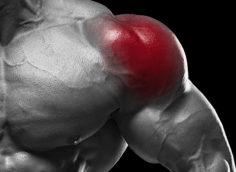Here's what you need to know...
- If you lift weights, you likely lack internal rotation in your shoulders. It can lead to serious pain and sabotage upper body size and strength development.
- Fortunately, you can easily test your degree of shoulder internal rotation and start taking steps to improve it.
- It takes time, but even a slight improvement will have a noticeable effect on your training, so keep at it.
If you lift weights, you likely lack internal rotation (I.R.) in your shoulder. This is a problem, because with a lack of internal rotation you can expect:
- Sub-optimal production in your bench, pull-up, bent-over row, and press.
- Sub-optimal upper body development.
- Joint pain.
All of this just from lifting weights? Believe it.
But I Feel Fine!
If you lack internal rotation, it's affecting you, even if you aren't experiencing pain. And just ignoring it won't make this limitation magically go away.
The problem is, if you lack this critical pattern, eventually your body will shut down force production to protect itself, thereby stopping your upper body size and strength development in its tracks. So get your head out of the sand and fix it!
Remember, good joint position and range of motion isn't just for physical therapy – it's for really good lifters, too. Take it serious and you'll be rewarded with immediate gains in strength and reduced pain in your shoulders. That's a serious win-win.
How Do I Find Out?
The video below breaks down how to check your internal rotation and shows ideal shoulder range of motion.
To assure that you do this test accurately, make sure you perform it lying on your back. You must maintain the original starting position shown in the video throughout the movement. Performing the test incorrectly renders it completely useless.
Don't freak out when you see how bad you are. You can be a good person and still have bad internal rotation – just don't leave it that way. Fix it!
How Can I Fix It?
Here's a series of videos to help correct the issue.
Note: Make sure you've fixed your t-spine first.
This first solution comes from an experience I had with a physical therapist. She'd tested my I.R. and found it was poor, so she immediately began digging on my 4-rib attachment. Within two minutes, my internal rotation was greatly improved. I was so impressed that I took this approach and modified it for you to try at home:
I have to give Kelly Starrett all the credit for the following I.R. solution. You may not have a therapist at your disposal to work on you, but you can certainly find a barbell in your gym. Be sure to pay attention to the placement of the bar in the video:
Once you've worked on rib limitations and added some internal rotation with the previous two solutions, you need to make it stick so you don't have to do this every day for the rest of your life by doing something Gray Cook calls a reciprocal reach. This is pattern re-education at its best. We're taking our newly developed range of motion and integrating it back in under better motor control:
What's the Payoff?
Better movement leads to better training, and in this case stronger shoulders, which will carry over to all of your main upper body lifts. Just be patient. It'll take some time to fix this issue, but even a small improvement will help you move and lift better, so strive for slow and consistent improvements as they'll eventually add up to better movement and better lifts.
Tell you what, why don't you all post how awful your internal rotation is below in the comments? At least it'll make everyone feel better mentally.





